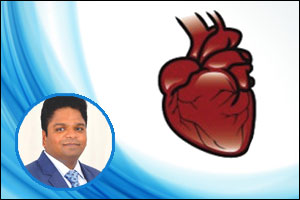- Home
- Editorial
- News
- Practice Guidelines
- Anesthesiology Guidelines
- Cancer Guidelines
- Cardiac Sciences Guidelines
- Critical Care Guidelines
- Dentistry Guidelines
- Dermatology Guidelines
- Diabetes and Endo Guidelines
- Diagnostics Guidelines
- ENT Guidelines
- Featured Practice Guidelines
- Gastroenterology Guidelines
- Geriatrics Guidelines
- Medicine Guidelines
- Nephrology Guidelines
- Neurosciences Guidelines
- Obs and Gynae Guidelines
- Ophthalmology Guidelines
- Orthopaedics Guidelines
- Paediatrics Guidelines
- Psychiatry Guidelines
- Pulmonology Guidelines
- Radiology Guidelines
- Surgery Guidelines
- Urology Guidelines
ST2: the new Biomarker for Heart Failure- Dr Babu Ezhumalai

Heart failure (HF) is associated with high mortality rates and globally a growing health problem. Biomarkers play an important role in the risk stratification of patients with HF. N-terminal of the pro-brain natriuretic peptide (NT-proBNP) is an established biomarker for the diagnosis and prognosis of HF. Nevertheless, the use of NT-proBNP has certain limitations, for example, the level of NT-proBNP is influenced by age, obesity, renal and liver function.
Suppression of tumorigenesis 2 protein (ST2) is a member of interleukin-1 (IL-1) receptor family and it exists in two forms such as membrane-bound form (ST2L) and soluble circulating form (sST2). ST2L is expressed together with its ligand interleukin-33(IL-33)by cardiomyocytes, vascular endothelial cells and fibroblasts in response to mechanical stress and cardiovascular injury. Binding of IL-33 to ST2L has been found to be cardioprotective by inhibiting myocardial fibrosis, hypertrophy and apoptosis, and preventing adverse cardiac remodelling. sST2 acts as a decoy receptor of IL-33 competes with ST2L for IL-33 binding and eliminates cardioprotective effects of IL-33/ST2L combination.
sST2 is the form measured by current assays such as Aspect-Plus and Presage assays. Increased concentration of sST2 in blood has been observed in conditions associated with cardiac fibrosis and remodelling as in congestive HF. It has emerged as a strong predictor of cardiovascular outcomes in both acute and chronic HF and its estimation provides independent as well as incremental prognostic value to NT-proBNP with regard to HF. Men tend to have higher ST2 levels than women. The association between ST2 and age and renal function is weaker than that seen with NT-proBNP, and the long-term intraindividual variation is lower. The recommended cut-point for ST2 in chronic heart failure (HF) is 35 ng/ml. Serial measurement of sST2 has been found to be useful in predicting response to therapy in HF. In acute and chronic HF, and after myocardial infarction (MI), higher ST2 levels are associated with worse symptoms and with an increased risk of rehospitalization and mortality. ST2 is equally predictive in HF with preserved and reduced ejection fractions.
ST2 levels are measured either on admission or within 48 hours in patients with MI or acute decompensated HF. ST2 levels may be useful for guiding therapy with mineralocorticoid receptor antagonists (MRA; i.e., spironolactone or eplerenone) after an MI, and for guiding β-blocker titration among HF patients. The ST2 level may be repeated 2 weeks after discharge for titrating doses of medications. ‘ST2 nonresponders’ are those whose ST2 levels fail to drop at least 15–25% within 2 weeks of an acute HF exacerbation and these individuals are at increased risk for adverse outcomes.
To conclude, ST2 is complementary to the natriuretic peptides for risk stratification in acute and chronic HF, and in predicting the risk of developing HF.2013 American Heart Association and American College of Cardiology guidelines for the management of HF provide a class IIb recommendation for the measurement of ST2 in patients with acute and chronic HF.
Dr Babu E, MD, DM, FNB, FACC, FESC, FSCAI, FAPSIC, is Consultant Heart Failure & Interventional Cardiologist at Heart Transplantation Unit, Fortis Malar Hospital, Chennai. He is Young National Ambassador of EAPCI for India.

Disclaimer: This site is primarily intended for healthcare professionals. Any content/information on this website does not replace the advice of medical and/or health professionals and should not be construed as medical/diagnostic advice/endorsement or prescription. Use of this site is subject to our terms of use, privacy policy, advertisement policy. © 2020 Minerva Medical Treatment Pvt Ltd